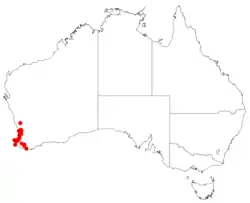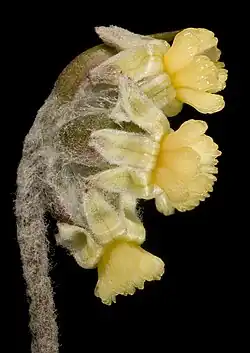Tribonanthes brachypetala
| Tribonanthes brachypetala | |
|---|---|
.jpg)
| |
| Scientific classification | |
| Kingdom: | Plantae |
| Clade: | Tracheophytes |
| Clade: | Angiosperms |
| Clade: | Monocots |
| Clade: | Commelinids |
| Order: | Commelinales |
| Family: | Haemodoraceae |
| Genus: | Tribonanthes |
| Species: | T. brachypetala
|
| Binomial name | |
| Tribonanthes brachypetala | |

| |
| Occurrence data from the Australasian Virtual Herbarium for T. brachypetala | |

Tribonanthes brachypetala (common name Nodding tiurndin) is a species of the genus Tribonanthes in the bloodwort family, Haemodoraceae[2] native to south western Western Australia.
It was first described by John Lindley in 1840.[2][1] It is a tuberous perennial herb growing from 0.2 to 0.4 m high,[3] in swamps and areas which are seasonally wet.[4] It flowers from July to August.[3]
The species epithet derives from the Greek brachys (short) and petalon (leaf, but here referring to petals) and describes the plant as having short petals.[2]
References
Wikimedia Commons has media related to Tribonanthes brachypetala.
- ^ a b John Lindley (1839), A sketch of the vegetation of the Swan River Colony, pp. xliv, Wikidata Q2819904
- ^ a b c d "Tribonanthes brachypetala". Australian Plant Name Index, IBIS database. Centre for Plant Biodiversity Research, Australian Government.
- ^ a b "Tribonanthes brachypetala Lindl". FloraBase. Western Australian Government Department of Biodiversity, Conservation and Attractions.
- ^ T.D.Macfarlane. "Tribonanthes brachypetala". Flora of Australia. Australian Biological Resources Study, Department of Climate Change, the Environment and Water: Canberra. Retrieved 2011-09-01.